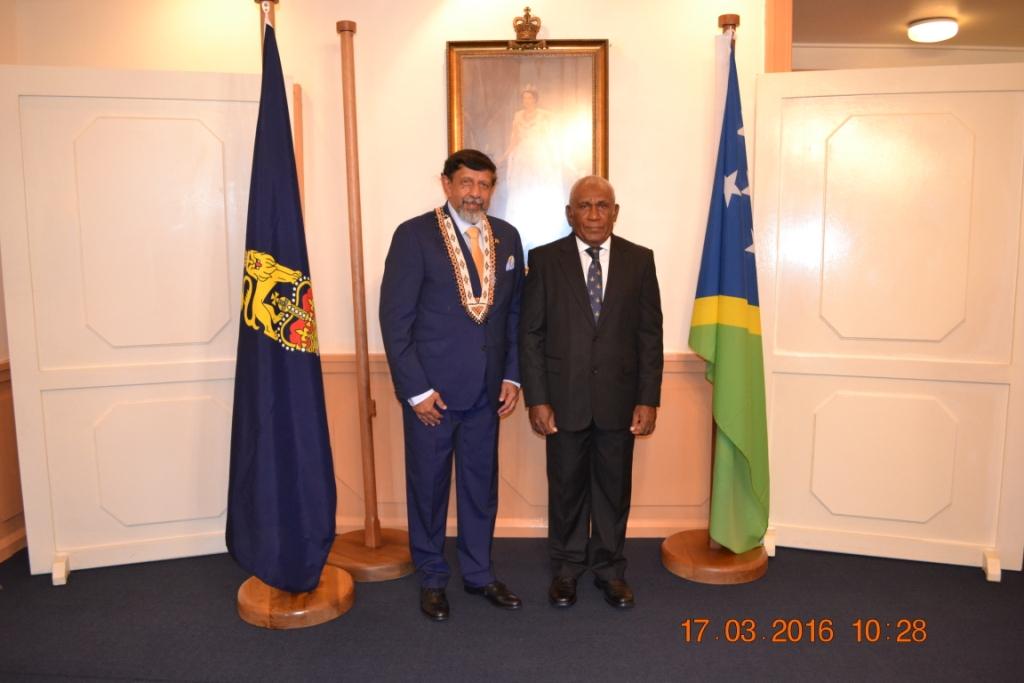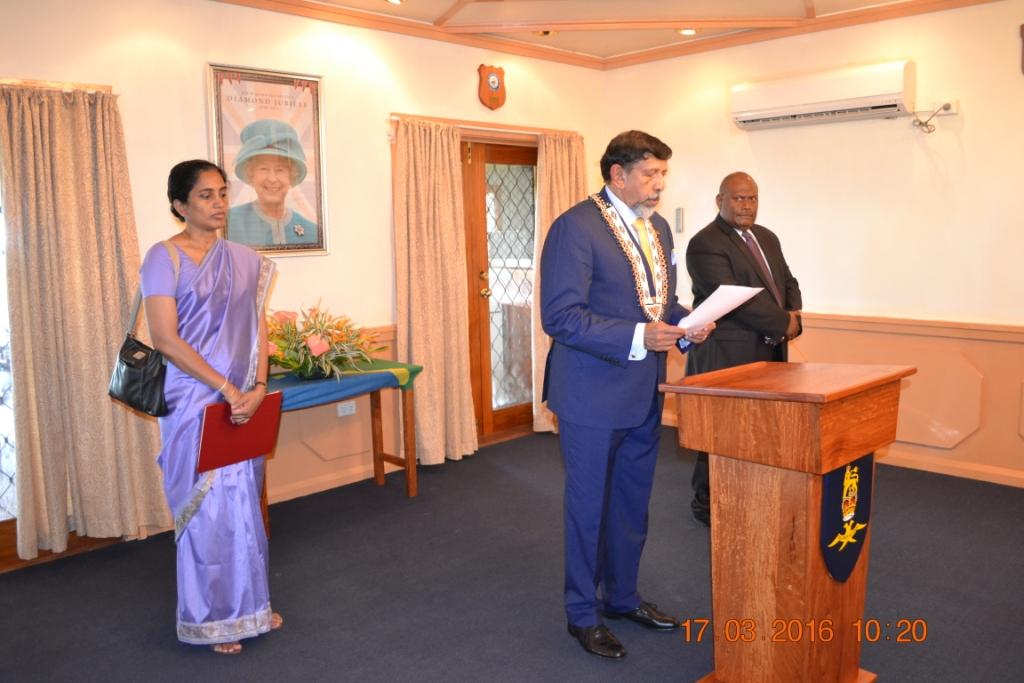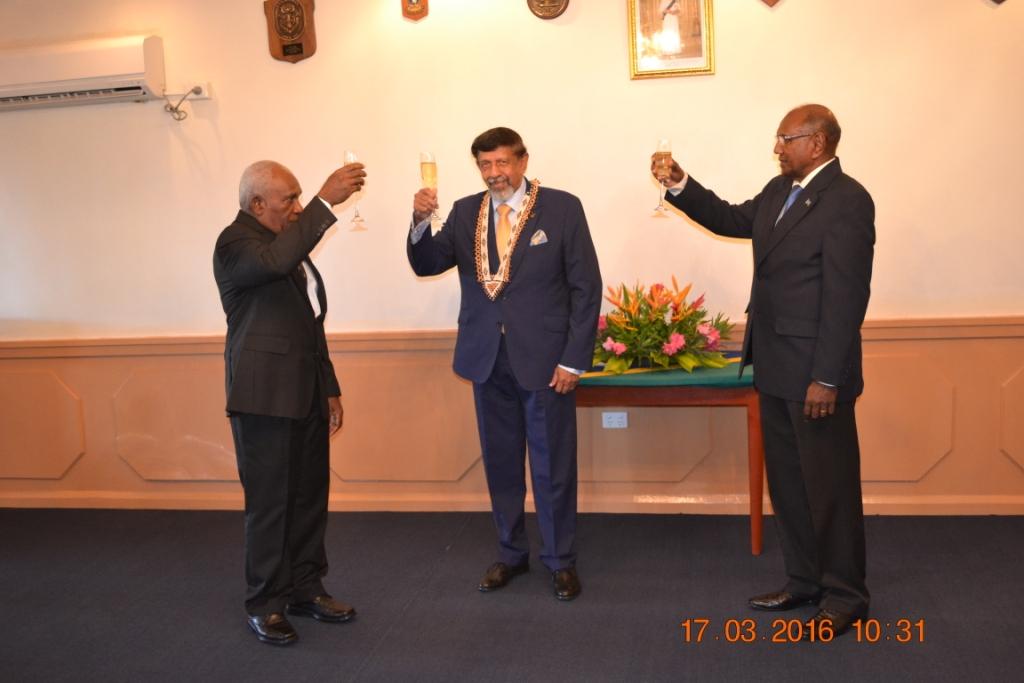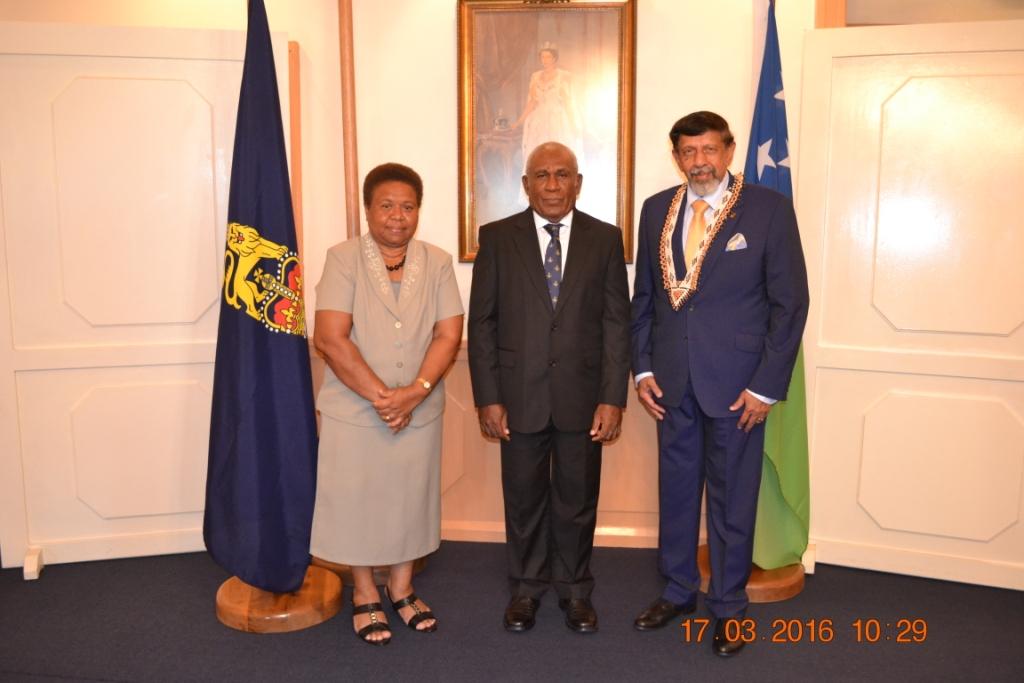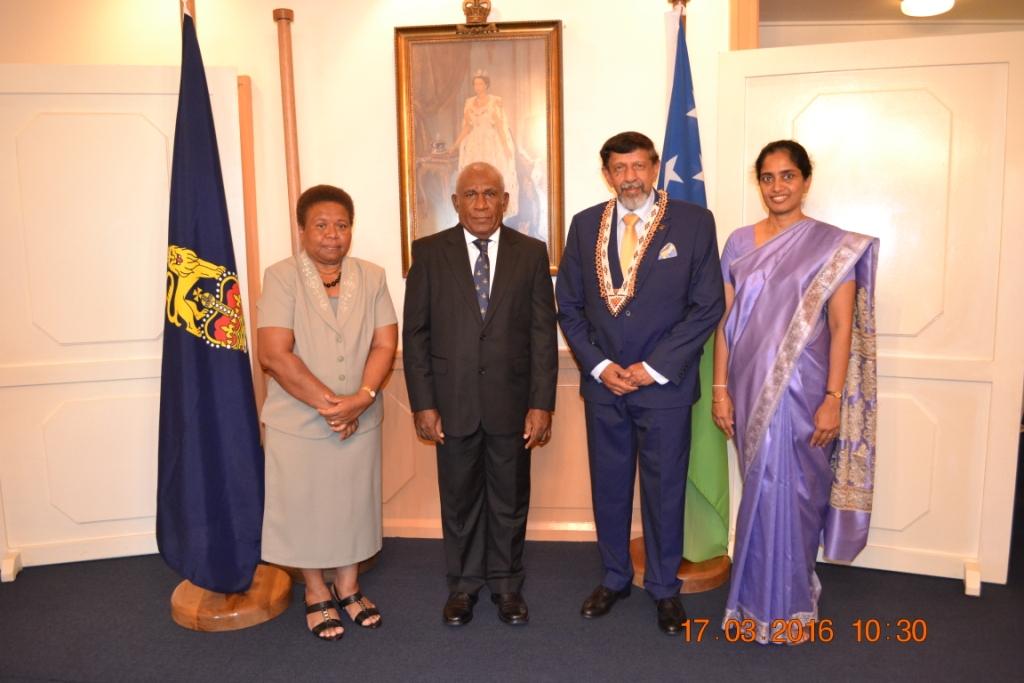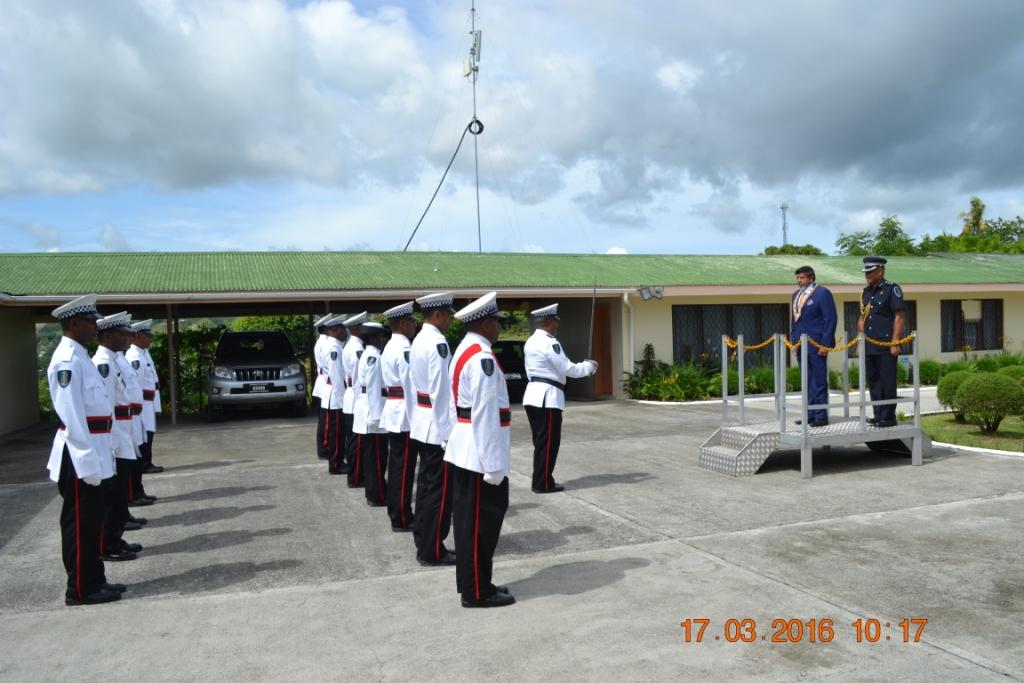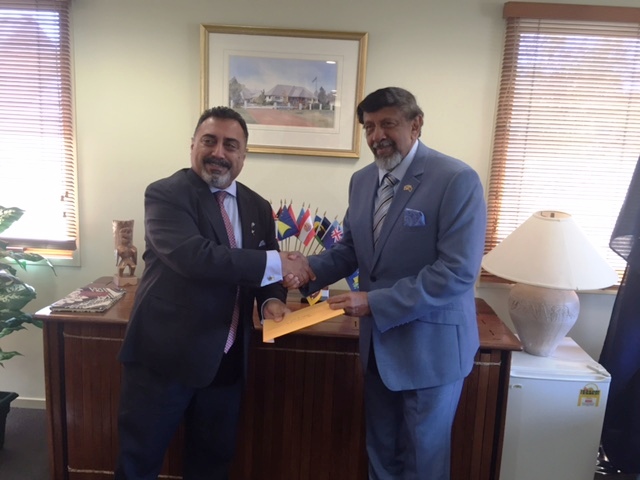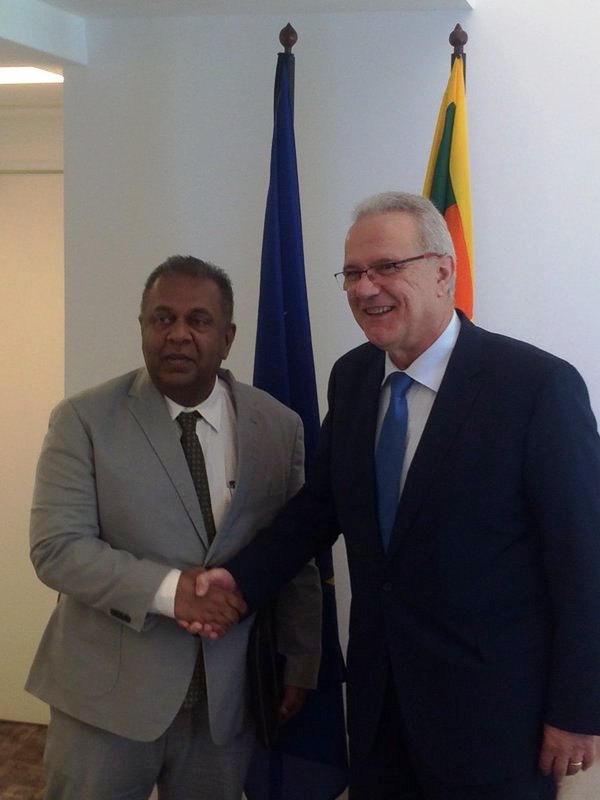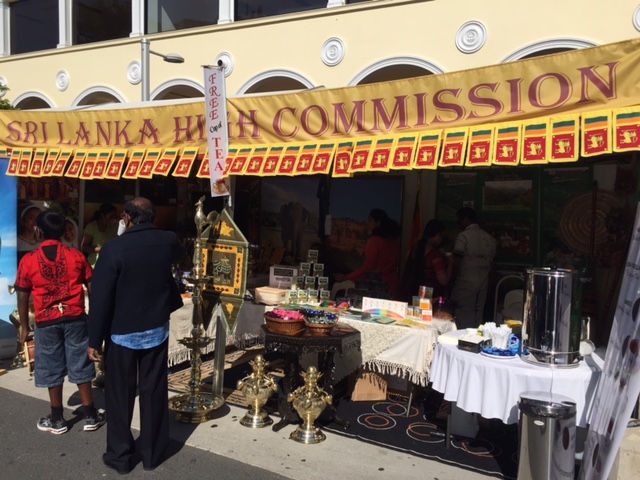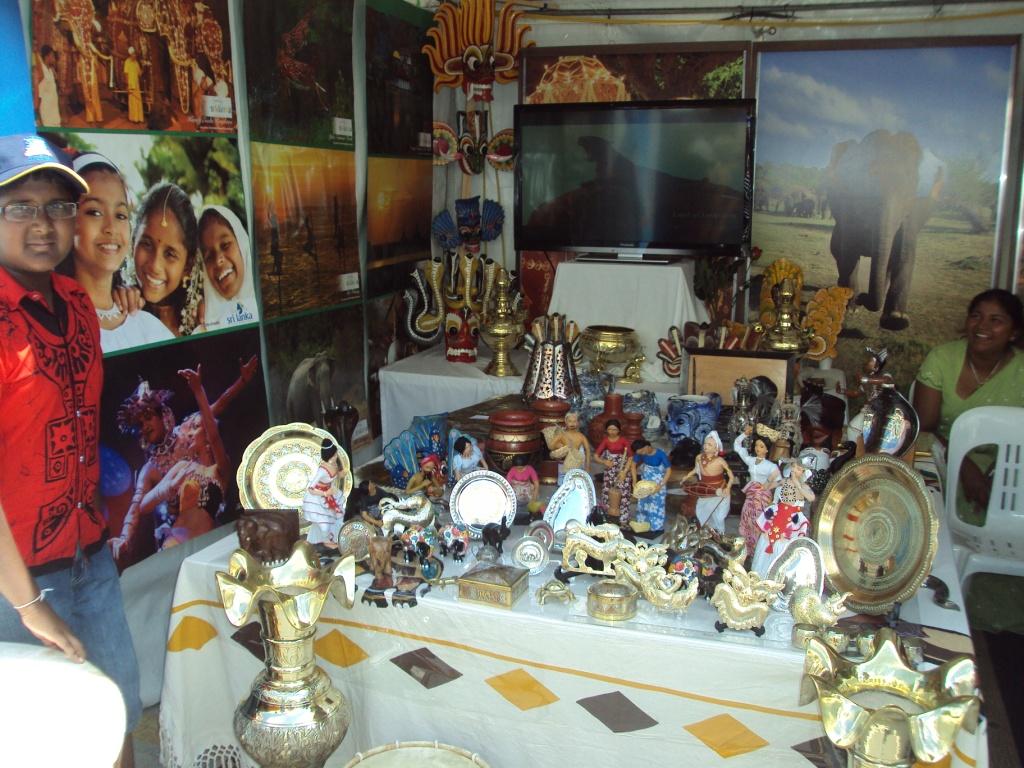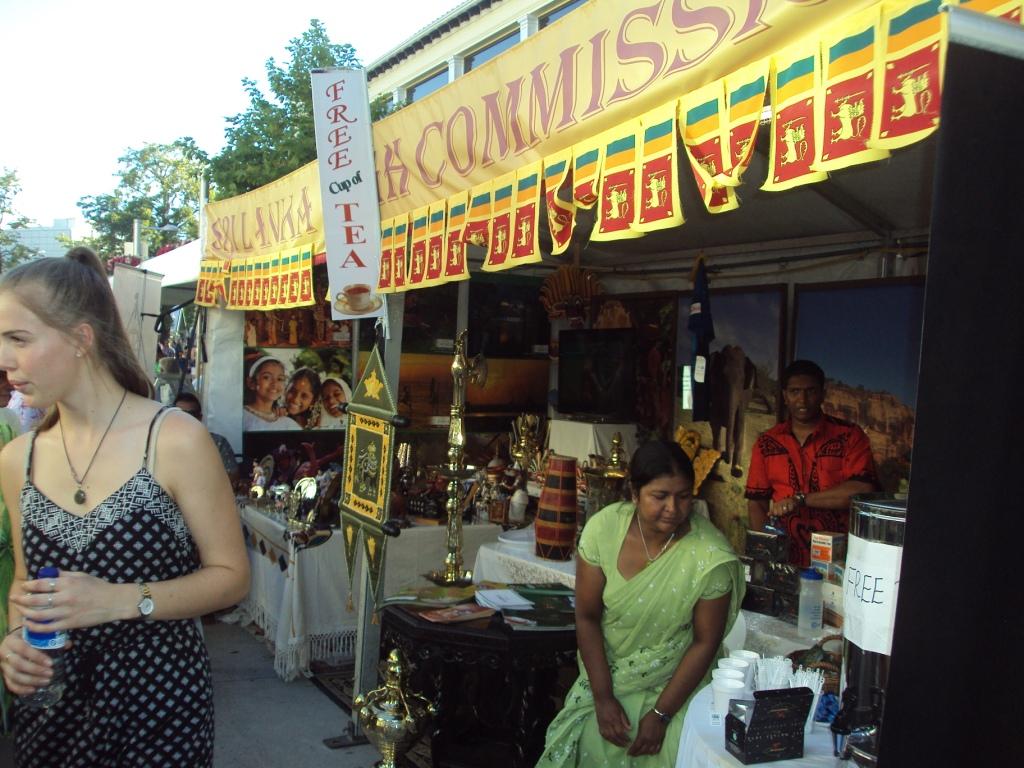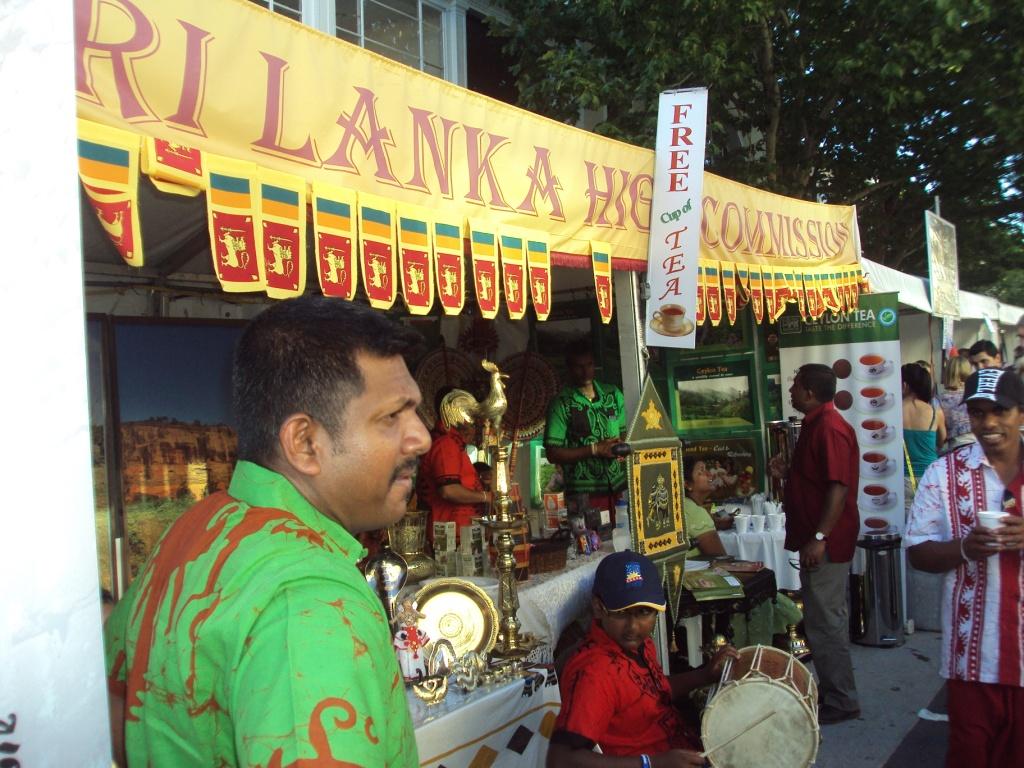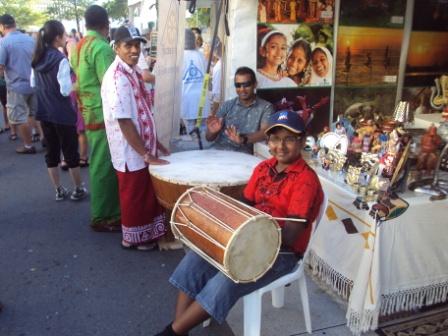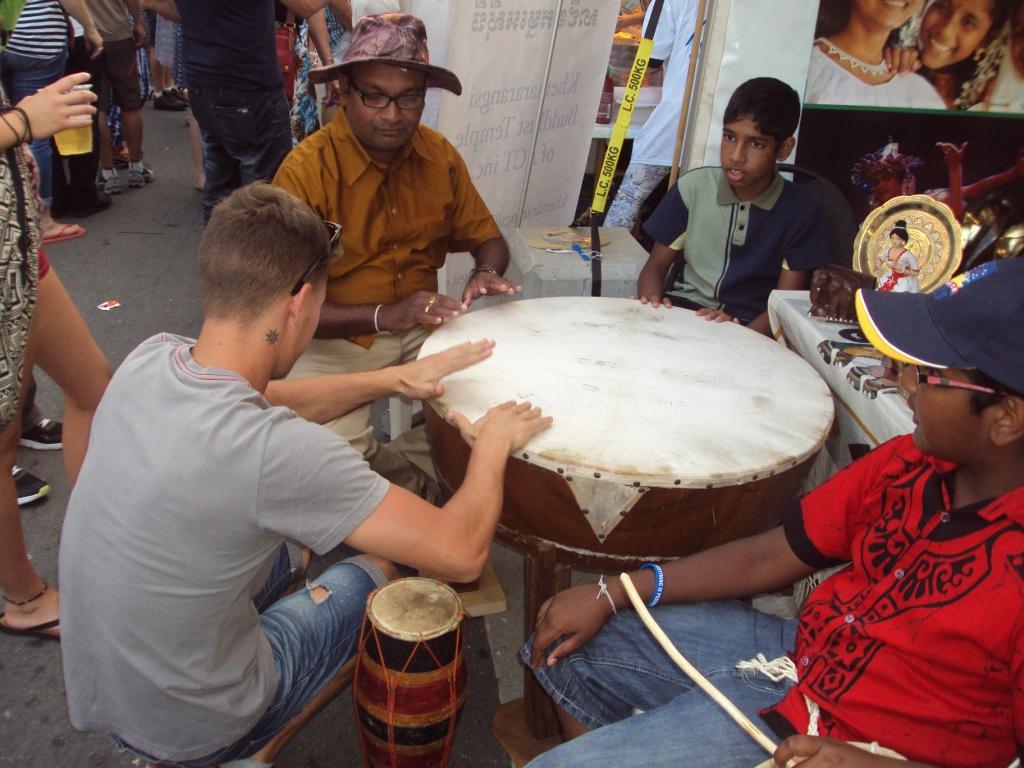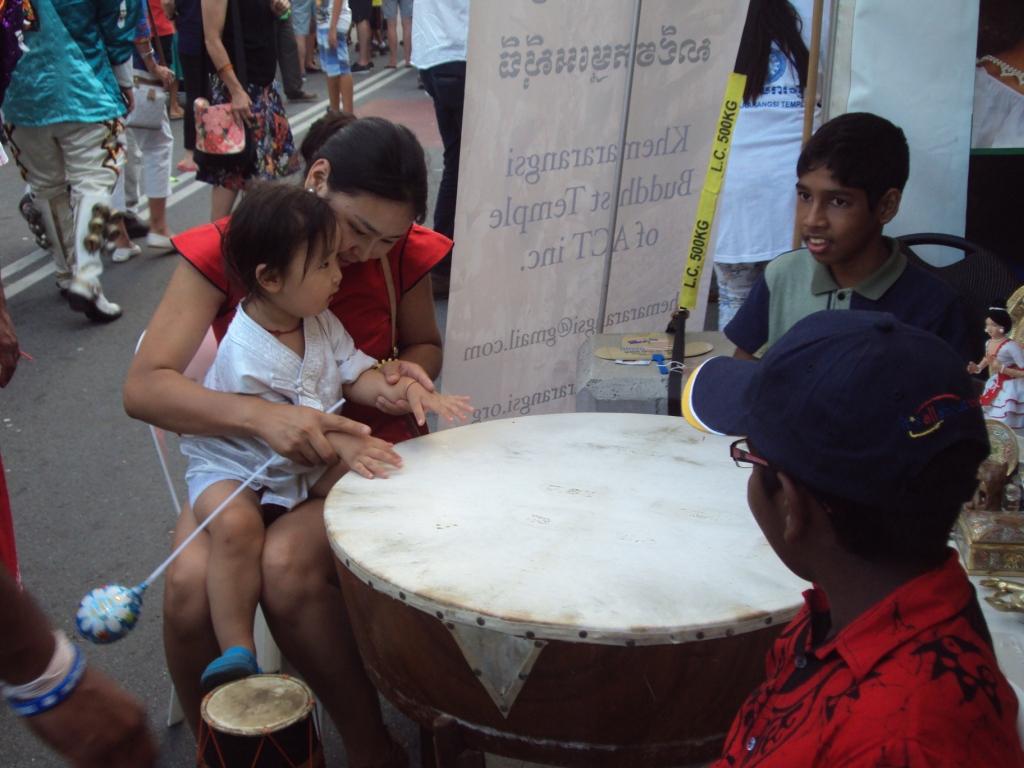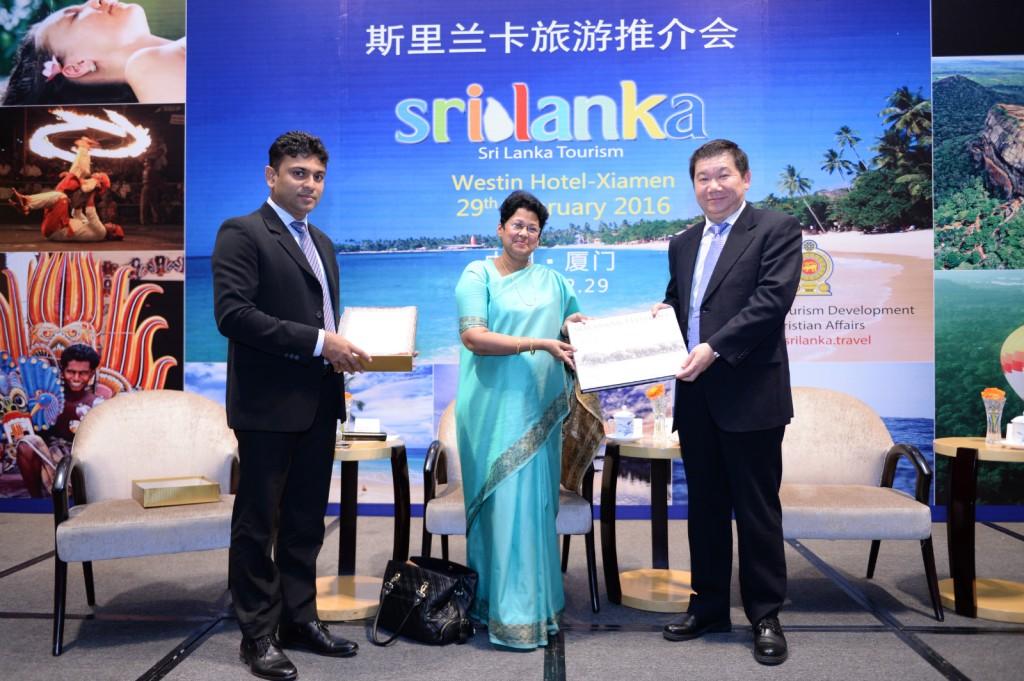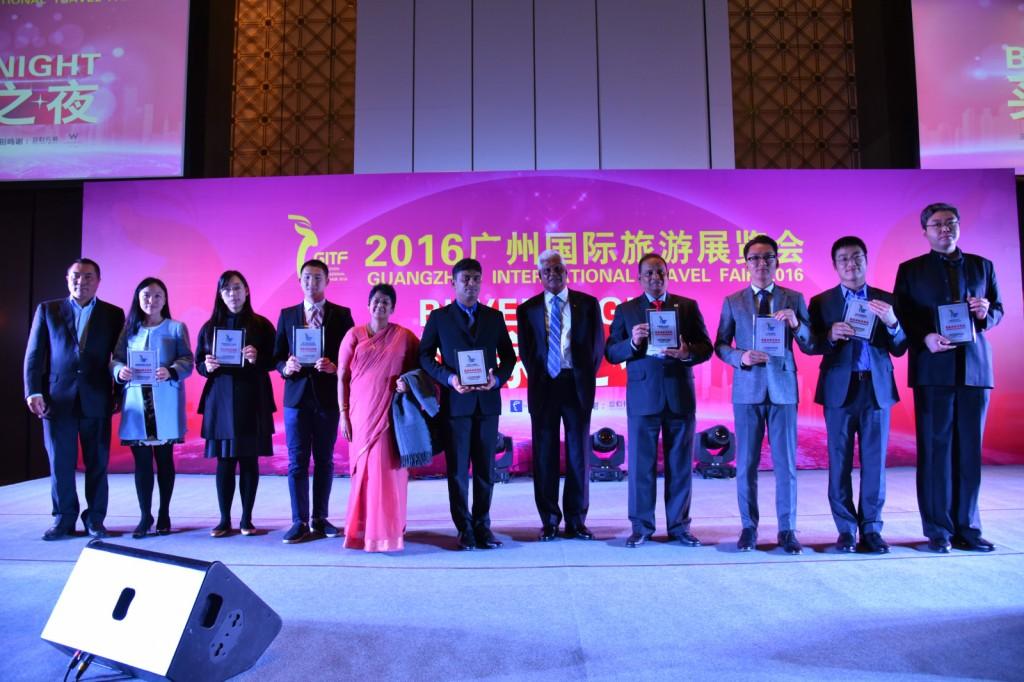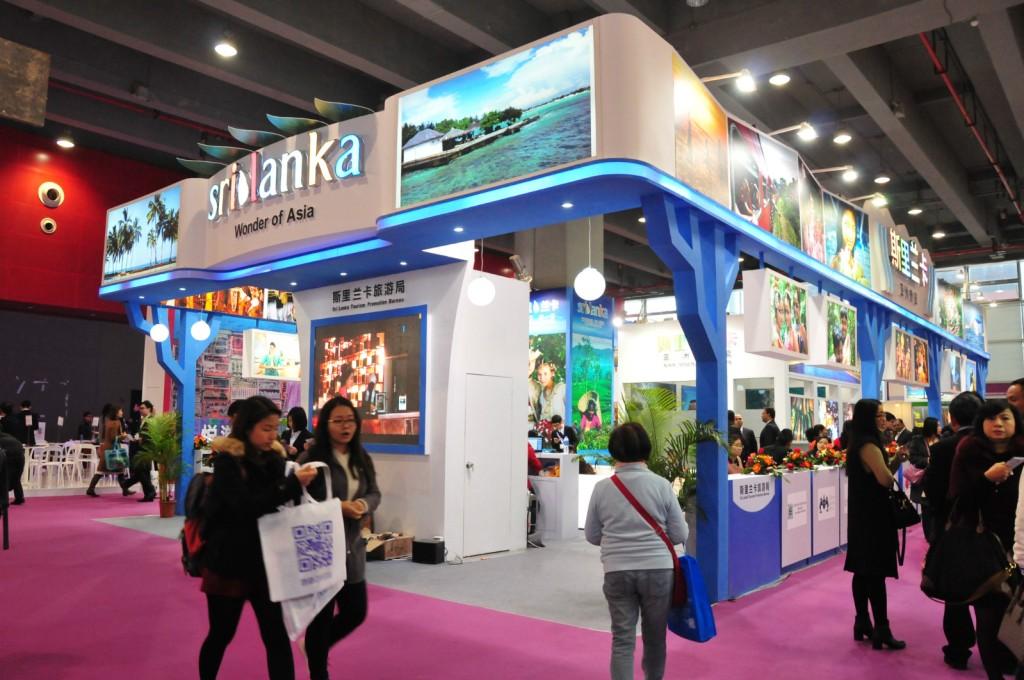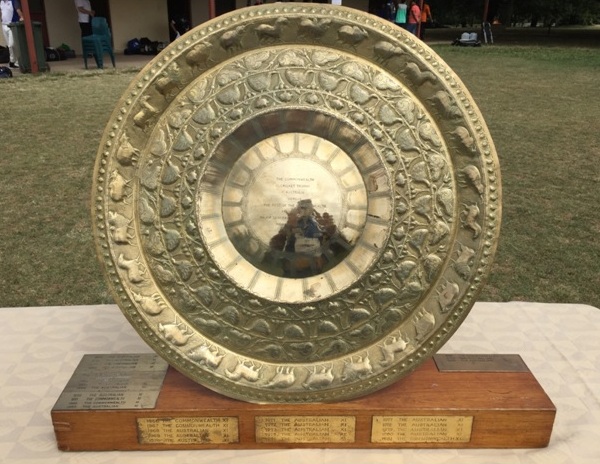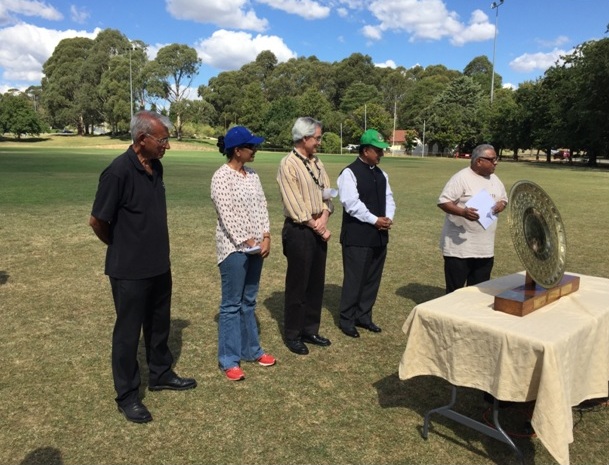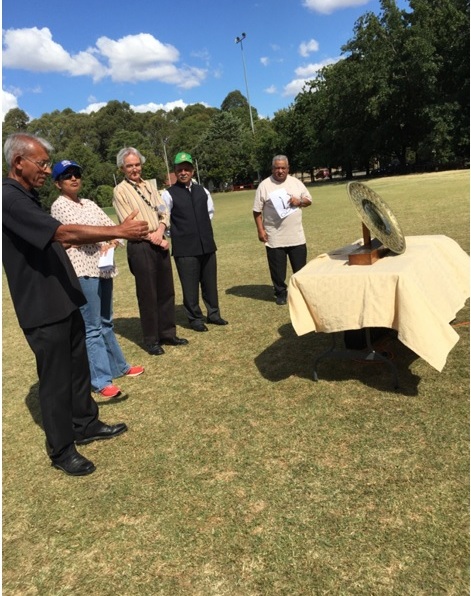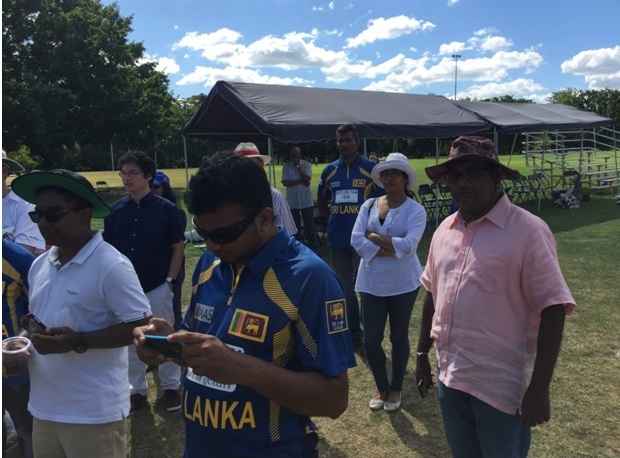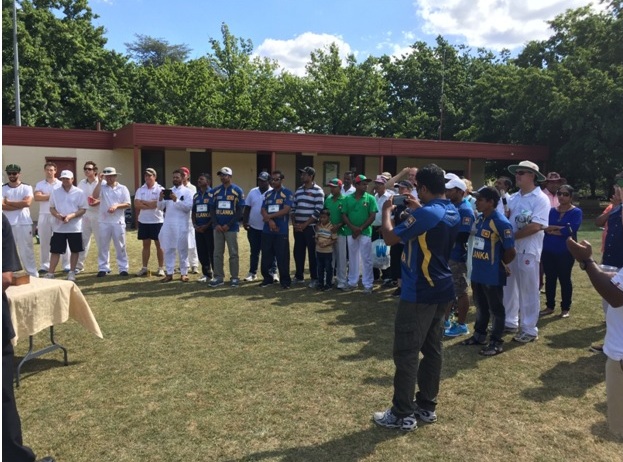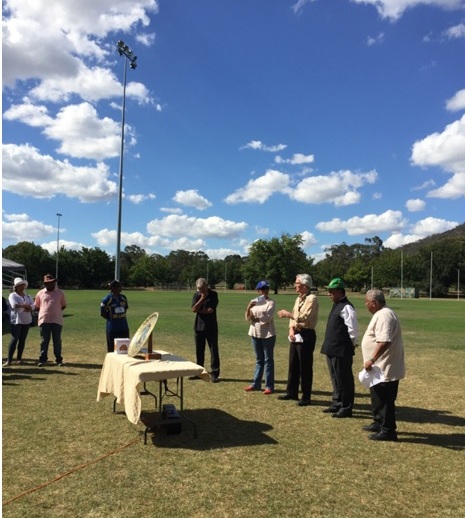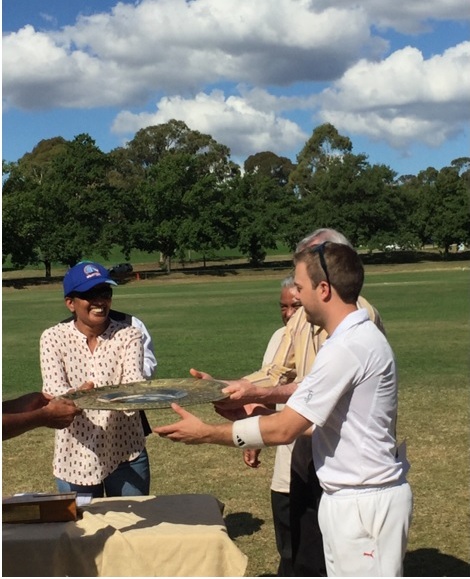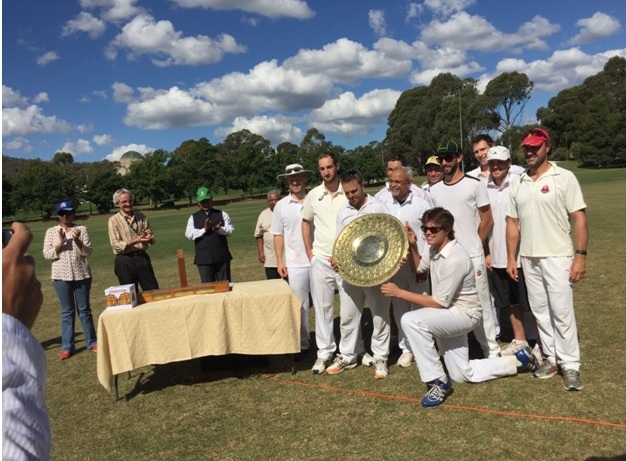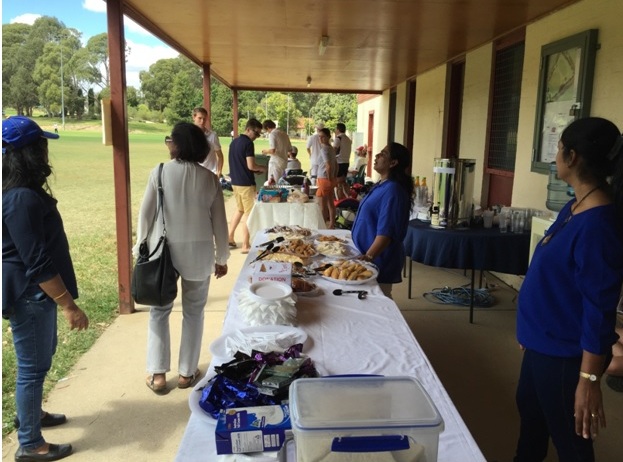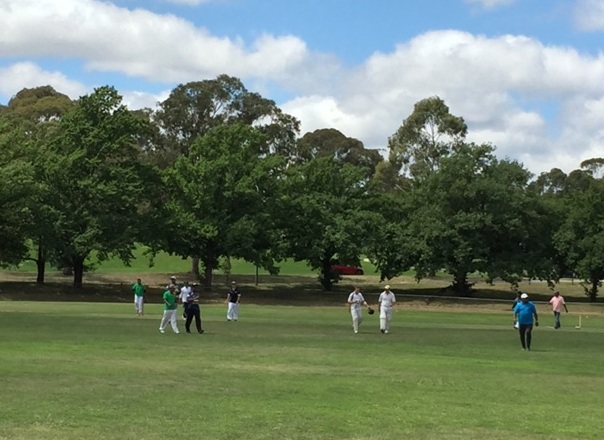


High Commissioner of Sri Lanka Presents credentials in Solomon Islands
April 11, 2016
High Commissioner Somasundaram Skandakumar presented credentials to the Governor General of Solomon Islands Sir Frank Ofagioro Kabui in Honiara on 17th March 2016. The High Commissioner was welcomed with the traditional garlanding of shell money and a Guard of Honour at the Governor General’s House. Speaking at the occasion, High Commissioner Skandakumar said that as island nations Sri Lanka and Solomon Islands share common interests and concerns, which can be focussed in furthering bilateral relations. The High Commissioner briefed on the new political direction of the Government in Sri Lanka, which aims at fostering reconciliation, democratic values and economic development.
The Governor General appreciated the initiatives of the Sri Lankan Government and highlighted the need to build on the bilateral relations, which were established in 2013, for mutual benefit. Referring to the legal and commercial fields as potential areas for cooperation the Governor General recalled with fond memories six months spent in Sri Lanka in 1976 under a Commonwealth training programme.
The High Commissioner called on Prime Minister Manasseh Sogavare and Foreign Minister Milner Tozaka during the visit, and was hosted to lunch by the Permanent Secretary to the Ministry of Foreign Affairs and External Trade Joseph Maahanua. He also interacted with the small but influential Sri Lankan community in Honiara.
Sri Lanka High Commission
Canberra
11th April 2016
Australian grant assistance for the development of netball in Sri Lanka
April 7, 2016
Foreign Minister Mangala Samaraweera, was associated with the launch of the Asian Sports Partnerships (ASP) programme by Australian Foreign Minister Julie Bishop on 6th April, through which grant assistance will be provided for further development of netball in Sri Lanka. The launch of the ASP took place in Sydney, during the recent visit of Minister Samaraweera to Australia on a 3 day official visit.
Welcoming Minister Samaraweera’s presence at the launch, Australian Foreign Minister Julie Bishop said that Australia is home to a large Sri Lankan community which creates a strong cultural bond between the two countries. She further announced that under the Asian Sports Partnerships Programme, Netball Australia “will deliver community development and peace building programs in partnerships with Sri Lankan community organisations.”
Thanking Australia for the grant assistance, Minister Samaraweera observed that sports play an important role in our bilateral relations with Australia, and pointed out that Cricket Australia has been a longstanding partner in the development of cricket in Sri Lanka. Sri Lanka’s High Commissioner to Australia Somasundaram Skandakumar and Consul General in Sydney Lal Wickrematunga, were also present.
Sri Lanka High Commission
Canberra.
7th April 2016
Address of Foreign Minister Mangala Samaraweera, MP at the Australian Institute for International Affairs Roundtable Victoria, 4th April 2016
April 6, 2016
On January 8th last year, in a historic election, the people of Sri Lanka cast their votes for democracy, reconciliation and development. They chose free and fair elections, good governance and the rule of law over authoritarianism and impunity; they chose stability, reconciliation and peace over the politics of fear and hate. And they eschewed isolationist crony capitalism for openness to the world and a competitive, transparent rules-based economy. Basically, the people of Sri Lanka were weary of politics and governance that just wasn’t cricket. They wanted the new Sri Lanka with an undoctored pitch, an untampered ball and genuine umpires.
The new government was left to clean the Augean stables – a debt-ridden economy, a divided country and gross corruption. While a great more needs to be done, in the last year there is no one who doubts that there has been a sea change in Sri Lanka. In fact, Samantha Power, the US Ambassador to the UN said, “I cannot think of a country in the world today where there has been this much change in such a short a period of time”. So, Ladies and Gentlemen, allow me to begin my talk today by briefing you on Sri Lanka’s progress and plans and then moving on to touch on the Sri Lanka-Australia Partnership.
As many of you here today know, during the previous authoritarian government Sri Lanka, the oldest democracy in Asia, stood at the precipice of dictatorship. But we succeeded in pulling back for that chasm in the last minute. In the last year we have reversed Sri Lanka’s trajectory and our democracy is rapidly consolidating. In fact, within months of securing office, the government swiftly passed a constitutional amendment separating powers, strengthening checks and balances and ensuring the integrity of the electoral process. That amendment reduced the powers of the presidency and re-instated term limits, ensured the independence of the judiciary, law enforcement and state officials, and made the Right to Information a fundamental right.
But this government, is going beyond reversing the undemocratic laws of the previous government. We are now ensuring that Sri Lanka reaches the next stage in its democracy moving from a ballotocracy to a fully-fledged modern democracy. Sri Lanka has made historic strides to entrench our democratic culture, promote accountability and consolidate the deliberative and participatory aspects of democracy. We have restored the freedom of the press, ended censorship and invited exiled journalists to return to Sri Lanka. A Right to Information Act has been tabled in Parliament and we will be voting on it shortly. Hundreds of criminal investigations for abuses of power and corruption are currently underway under the due process of the law. We just put in place a 25 percent reservation for women in local government elections. Once these reforms are over Sri Lanka’s democracy will be truly accountable, participatory and inclusive.
But perhaps more than the importance of consolidating Sri Lanka’s democracy, the need of the hour is breaking through the greatest obstacle that has held Sri Lanka back since Independence – our failure to accept and celebrate the our small island’s tremendous diversity.
At the time we gained Independence, in February 1948, Sri Lanka, then Ceylon, was in a unique position among the countries in the developing world as she had experience of representative government and development indicators that were unparalleled in the developing word. In fact, an editorial published in London on the day of Sri Lanka’s independence predicted that in a short space of time Ceylon would become the Switzerland of the East.
But what held us back, what plunged us into cycles of conflict, and what prevented the many attempts of saving our nation from such adversity was the failure to manage such justifiable grievances of Sri Lanka’s minorities that led to conflict and violence. Sri Lanka’s post-independence leadership was unable to terms with her diversity as a multi-ethnic, multi-cultural, multi-religious and multi-lingual country. As a result these grievances were transformed into inter-communal resentment, feelings of discrimination, unfair treatment and ultimately political violence.
But for the first time in Sri Lanka’s history, the two main political parties of the country, who have been opposed to each other since Independence, have come together to win the peace once and for all. Next Tuesday, on the 5th of April, Parliament will meet as a Constitutional Assembly to design Sri Lanka’s Third Republican Constitution which will strengthen democracy, guarantee the rights of individuals and minorities and reflect the needs and aspirations of all our citizens. For the first time in Sri Lanka’s constitution-making history, these deliberations will be enriched by a comprehensive process of national consultations.
Similarly, the Government knows that we need to understand and deal with the past if we are to move forward as a country. Based on the Government’s four pillared approach of truth, accountability, reparations and non-recurrence, a resolution was moved at the UN Human Rights Council which we co-sponsored. The design of the mechanisms proposed by the Government and included in the resolution, namely the Missing Persons Office, the TRC, the Accountability Mechanism and the Office of Reparations, will be based on consultations with all stakeholders – particularly the victims. Online consultations have already begun and face-to-face consultations will begin within weeks.
But for Sri Lanka’s democratic and reconciliation journey to succeed, its economy must flourish and its people must prosper. The government is currently putting in place the medium-term elements for unleashing Sri Lanka’s tremendous economic potential.
Sri Lanka is enjoys a unique geo-economic position located in the middle of the Indian Ocean, on the main East-West Sea Route and at the maritime Gateway to India and the Sub-Continent. In a nutshell, we are at the center of the emerging world. Alongside Dubai, Singapore and Hong Kong, we are putting in place the necessary conditions to make Sri Lanka a node for access to the emerging world.
Sri Lanka already has free trade agreements with India and Pakistan and negotiations are already underway to deepen these agreements. We have ongoing negotiations with China on signing an FTA. Once these agreements are in place, Sri Lanka will have deep concessionary access to the two largest emerging markets. In addition to securing access to new markets, Sri Lanka is regaining access to old ones. The previous government’s human rights record led to the loss of GSP+ concessions to the EU – we are working very hard to restore them as soon as possible and the EU’s response has been very favourable.
Sri Lanka has long been a paradise for Australian tourists, surfers in particular are no strangers to Hikkaduwa or Arugam Bay. But now Sri Lanka is becoming a paradise for investors – we have taken substantial steps to make the judiciary independent, there is a concerted effort to increase the ease of business and Sri Lanka’s infrastructure, already the best in the region, is improving fast too. We also enjoy macro-economic stability. Over the last five years average GDP growth exceeded 6 percent, inflation never exceeded 7.5 percent and the government is now putting in place a framework with the IMF for fiscal and external sector consolidation that will put the Sri Lankan economy on a firm foundation for growth.
Sri Lankan firms have invested over 200 million dollars in Australia, compared to the 60 million dollars Australian firms have invested in Sri Lanka. With the tremendous opportunities opening up in Sri Lanka and her neighbors, it’s time to reverse that ratio. Sri Lanka’s burgeoning tourism sector, underdeveloped diary industry and rich but unexploited ocean area also offers excellent value propositions for Australian leisure, diary, fishing and aquaculture and offshore sectors.
Sri Lanka and Australia have had close ties for generations. Many Australian brands – including Anchor milk – are household names in Sri Lanka and Colombo was a key stop on voyages between the UK and Australia. In more recent years Australia has become the home of over 120,000 persons of Sri Lankan origin – with an eclectic mix of Burghers, Tamils, Muslims and Sinhalese. Australia is also a favoured destination for Sri Lanka students: over 5500 Sri Lankans are studying at Australian universities. Sri Lankan Airlines opened its first office in Australia, here in Melbourne, in 2013 and airlines are exploring the possibility of re-commencing the direct flights between our two islands.
In addition to these ties, Sri Lanka and Australia, neighboring island in the Indian Ocean, share a deep commitment to democratic values and many common interests. We are committed to combatting violent extremism, a rules based international order and freedom of navigation. We also have a common interest in addressing issues of climate change and human trafficking.
As Prime Minister Turnbull noted a couple of weeks ago at the annual Lowy Lecture,
Strong borders, vigilant security agencies governed by the rule of law, and a steadfast commitment to the shared values of freedom and mutual respect – these are the ingredients of multicultural success – which is what we have achieved in Australia.
In an increasingly unstable world, where democracy, multiculturalism and human rights are threatened from all quarters, Sri Lanka, like Australia, has the potential to set such an example and become a pillar of stability in the region.
But for Sri Lanka to succeed the people of Sri Lanka need to feel the democratic dividend and the peace dividend fast. Australia has been generous in her assistance providing over 40 million US dollars over the last year, and in helping us guard our maritime area which is nearly five times our land areas. But at this time of transition, we need Australian assistance in rebuilding, in education – particularly vocational education, in technology and in improving public service delivery.
Therefore, ladies and gentlemen, at this critical point in Sri Lanka’s transition, when the people of Sri Lanka rejected those who just weren’t playing cricket and are ready to bat again, we look to our partner Australia’s support and the world’s support for the next innings.
Address by Foreign Minister Mangala Samaraweera at Lunch Meeting with Business Leaders and Parliamentarians Melbourne, 4 April 2016
April 6, 2016
On the eight of January last year, in a historic election the Sri Lankan people voted for democracy, reconciliation and development, the three pillars on which the government is taking the country forward today. They chose robust democratic institutions over kleptocracy and authoritarianism, they chose healing and unity over hate and division and they chose a development strategy based on free competition and a level playing field over a system of crony capitalism.
As a result, Sri Lanka, the oldest democracy in Asia, which has faced two Marxist insurgencies, a civil war and nearly a decade of self-imposed international isolation, is now on the verge of a renaissance. The new government has a clear mandate and is putting in place the foundations for political and policy stability, growth and development, in addition to regaining Sri Lanka’s role at the centre stage of international affairs.
The government has already significantly strengthened the separation of powers and checks and balances. Within months of coming to office, the government passed a constitutional amendment that limited the powers of the presidency and strengthened the independence of the judiciary, bribery commission and other key public bodies. It also took immediate steps to end censorship and allow a completely free media. And I can assure that the Fourth Estate is more than active in holding the government to account. The government is also committed to ensuring that Sri Lanka’s democracy isn’t reduced to ballotocracy: we are strengthening the deliberative and participatory aspects of democracy. For example, parliament recently approved a 25 percent quota for women at local government level and a Right to Information Bill has been tabled in parliament.
In fact, tomorrow, Parliament will be convening for the first time Constitutional Assembly in order to start the process of designing Sri Lanka’s third republican constitution that will further strengthen parliament, the courts and independent bodies and reduce the centralization of power in the presidency.
The new constitution is also one of three main prongs of the Government’s reconciliation strategy. For it is our failure as a country to accept and celebrate our diversity and address the justifiable grievances of our different communities that caused the ethnic conflict and war. In fact, if not for this, Sri Lanka would have most likely fulfilled the destiny that we predicted in a London newspaper on the day of her independence, nearly seventy years ago, and become the “Switzerland of the East”. The new constitution will ensure that power is shared so that citizens are empowered to be involved and have a greater say in the decisions that affect their lives and help ensure that the country is truly united.
The second prong is coming to terms and dealing with our past. We know that if we are to move forward this is necessary, so Sri Lanka co-sponsored a resolution in Geneva that outlines a four pillar approach based on truth, accountability, reparations and non-recurrence. Consultations on the design of the Missing Persons Office, TRC, Accountability Mechanism and Office of Reparations are currently underway.
Third, we are addressing the plethora of issues that remain in the conflict affected areas of the island. One of the first steps the government took was the restoration civilian administration in the North and East, the government has released over 3400 acres of land and we are working hard to improve living standards.
But in addition to domestic political stability, the government is also helping ensure stability in the region. We have re-balanced our foreign policy so that we now have excellent ties with our neighbour India, in addition to our traditional friends such as China, the US, EU and Japan. After several years we’ve had Joint Commissions with India and the EU. Sri Lanka and the US formalized their partnership for the first time in the form of the Partnership Dialogue that Secretary Kerry and I initiated in February this year. Our relations with China remain strong and I am in fact going from Sydney to Beijing to join Prime Minister Wickremesinghe who is paying an official visit to China.
We are in the process of collaborating with our partners, including Australia, in countering violent extremism, securing Sri Lanka’s vast maritime area which is nearly five times that size of its landmass and protecting Indian Ocean shipping routes from piracy.
Sri Lanka looks forward to working closely with Australia to ensure the maritime security of the Indian Ocean as both parties are committed to ensuring freedom of navigation and a rules-based international order. We also need to work together on issues of climate change that is already seriously affecting our environments and economies. Our relations with Aussie remain cordial and as strong as ever, and I hope that my bilateral discussions with Foreign Minister Julie Bishop tomorrow will form the basis for increasing the depth and breadth of our relationship in the coming years.
For the first time since Independence there is tremendous hope that this vision for a democratic, truly united, peaceful and prosperous country can be achieved. This is because the two main political parties that have opposed each other from independence have joined together, for the first time in history, in a grand coalition so that they can collectively address these long-standing issues once and for all.
In fact, the recent unanimous decision to make Parliament a Constitutional Assembly, which which starts work tomorrow, and the approval of the budget last December with the largest majority any government has ever achieved, shows that this government is more stable than any other government since independence – despite the infantile and opportunistic machinations of a small faction of the opposition comprised of bankrupt politicians.
As a result, the coming years will not only see political stability but macro-policy stability as well, despite the usual day-to-day complexities of coalition government. The government is committed to achieving its promises for growth and employment. The only way we can do this is by ensuring macro-economic stability, increased market access and an improved investor climate.
The government is currently negotiating with the IMF for a stand-by facility and our economy has proved its macro-economic resilience. Over the last five years average GDP growth exceeded 6 percent, inflation never exceeded 7.5 percent and the government is now putting in place a framework with the IMF for fiscal and external sector consolidation that will put the Sri Lankan economy on a firm foundation for growth.
We are leveraging Sri Lanka’s unique geo-economic position at the centre of the emerging world – located in the Middle of the Indian Ocean, next to the main East-West Sea Route and at the mouth of the Indian Sub-Continent – by improving market access for Sri Lankan goods and services in the Indian and Pakistani markets. We are building on existing free trade agreements with India and Pakistan and we in negotiations to sign a free trade agreement with China. As a result in addition to excellent connectivity to the emerging world, Sri Lanka will have deep concessionary access to the largest emerging markets. We are also regaining access to lost markets, such as the EU, by improving our human record which will help us regain GSP+ concessions.
However, if Sri Lanka is to kick-start her economy FDI is essential and we are making Sri Lanka an investor’s paradise as well. We are working hard to cut-red tape, ensure investor security and improve Sri Lanka’s infrastructure, which is already the best in the region. We are reforming our tax system which is holding back our rank on the Doing Business Index, where we are already ranked the easiest place to do business in South Asia. But while we are located in South Asia, we are benchmarking ourselves against South East Asia. We are also streamlining the investment process with a one-stop investment shop in the form of the Agency for Development, which will also have significant private sector involvement. We have excellent ports, airports and roadways, in fact Colombo Port is the busiest in South Asia.
Sri Lanka is open to the world and open to foreign investment. We particularly need considerable investment in tertiary education – including vocational education, ocean industries and our diary sector. Our Ambassador in Australia, who has already done so much for Sri Lanka Australia relations through his yeoman service at Sri Lanka’s cricket board, and our two consul-generals, in Melbourne and in Sydney, will provide you any assistance you may require in exploring Sri Lanka. As for existing investors, I want to thank you for your confidence in Sri Lanka and I assure you that my ministry and the government are committed to partnering with you to make business easier and safer.

Sri Lanka hands over USD 25,000 and tea for Cyclone victims in Fiji
March 29, 2016
The Sri Lankan government has donated US$ 25,000, and 100kg of tea to the people of Fiji, as a symbolic contribution towards relief assistance in the aftermath of Cyclone Winston that ravaged the Fiji Islands last February.
The cheque was handed over by Sri Lanka’s High Commissioner in Australia Somasundaram Skandakumar, to the Fijian High Commissioner in Australia Yogesh Punja on 23rd March. The consignment of tea will be dispatched by the Sri Lanka Tea Board directly to the National Disaster Management Office in Fiji.
In handing over the cheque, High Commissioner Skandakumar said that Sri Lanka was well aware of the devastation that can result from a natural disaster, having immensely suffered from the 2004 tsunami. The symbolic donation is a reflection of the Sri Lankan people’s empathy towards the people of Fiji who are still in distress and struggling to overcome the destruction and damage caused by the Cyclone. He also referred to the very cordial relations that exist between the two countries, and expressed the hope that the resilience of the Fijian people will help them in facing the challenges ahead of them.
The Fijian High Commissioner thanked Sri Lanka for the symbolic gesture and explained the relief assistance underway to help the people in the affected areas.
Sri Lanka High Commissioner
Canberra
29th March 2016
EU Commissioner for International Cooperation and Development Visits Sri Lanka
March 16, 2016
The EU Commissioner for International Cooperation and Development Neven Mimica arrived in Sri Lanka today, 15th March 2016, to re-affirm EU support for the Government of Sri Lanka, review ongoing development programmes and to discuss ways and means of further enhancing Sri Lanka – EU bilateral cooperation. This is the first visit of the EU Commissioner for International Cooperation and Development to Sri Lanka and is the first visit by a high-level EU representative since the current Government assumed office.
The EU Commissioner will meet Prime Minister Ranil Wickremasinghe and other senior ministers during his visit.
Following the election of the new Government in 2015, Sri Lanka and EU are engaged in a number of initiatives aimed to complement the ongoing peace and reconciliation process while also strengthening economic partnership.
Today, Commissioner Mimca met with Foreign Minister Mangala Samaraweera and discussed a wide range of issues, including possible lifting of IUU fishing ban and restoration of GSP+, furthering the continued positive engagement between the two parties.
Foreign Minister Samaraweera also participated at the formal opening of the new premises of the Office of the EU Delegation today.
Commissioner Mimica will conclude his official visit on 17th March, 2016 following high level discussions and signing of two financing agreements.
Ministry of Foreign Affairs
Colombo
15 March 2016
High Commission participates National Multi Cultural Festival
March 7, 2016
Sri Lanka High Commission, as in previous years participated National Multi Cultural Festival held in Canberra from 12-14 February 2016.
Having organised an exclusive stall, the High Commission promoted Sri Lankan Cultural attraction and pure Ceylon tea.
With the assistance of the Sri Lanka Tea Board, the High Commission staff served black tea to the attendees of the event and distributed free tea bags. The High Commission stall was one of the attracted stalls in the Festival and many festival attendees visited the stall and shared their experience in Sri Lanka and inquired about Sri Lankan culture, tourism and Tea.
Sri Lanka wins Award for the “Most Popular Destination”at the Guangzhou International Travel Fair (GITF)
March 7, 2016
The Consulate General of Sri Lanka in Guangzhou in collaboration with the Sri Lanka Tourism Promotion Bureau(SLTPB)organized Sri Lanka’s participation at the Guangzhou International Travel Fair (GITF) from 25th – 27th February 2016 at the Canton Exhibition grounds in Guangzhou.
The GITF which is an annual event in Guangzhou and held since 1992 is considered one of the prestigious international travel fairs in the Asia Pacific region.
Sri Lanka which was the partner country at this year’s GITF under the theme “One Island Thousand Treasures” received the award for “Most Popular Destination” which gave a leveraging boost in enhancing Sri Lanka’s image as a diverse, exciting and premier travel destination. The dance troupe from the Sri Lanka Army which performed on the opening night was very well received by the audience.
Thirty Sri Lankan travel agencies participated in the GITF. They were able to connect directly with outbound tour operators, travel agents and other travel buyers through two Roadshows hosted by the Consulate General and the Sri Lanka Tourism Promotion Bureau in the Westin hotel in Guangzhou on 25th February and Xiamen city in Fujian province on 29th February which was very well attended by the Chinese travel industry and media.
Mr. Paddy Withana, Chairman of the Sri Lanka Tourism Promotion Board, Mrs. Shanika Dissanayake, Consul General of Sri Lanka in Guangzhou and Mr. Chinthaka Liyanaarachchi/ Head of the China Desk at the SLTPB addressed the gathering.
The Travel Fair attracted 956 exhibitors from 45 countries and regions.
Sri Lanka Consulate General
Guangzhou
3 March 2016
Address of Foreign Minister Mangala Samaraweera at the US Institute of Peace
February 27, 2016
Address by Hon. Mangala Samaraweera, MP Minister of Foreign Affairs of Sri Lanka US Institute of Peace, Washington DC – 25 February 2016Advancing Reconciliation and Development in Sri Lanka
Last February, soon after the election of President Maithripala Sirisena at the Presidential Election held on 8 January 2015, I stood before a similar audience in this great city and outlined our plans and our vision for Sri Lanka.
It has been just a year. But, looking back, it seems as if several years have passed since then. A year on, much has happened and much has been achieved.
The relationship between our two countries alone has experienced a veritable renaissance since the visit of Assistant Secretary Biswal in early February 2015 weeks after the Presidential elections and after my visit to Washington exactly a year ago. In such a short period of time, our relations have been strengthened to unprecedented heights. In fact, although our countries have maintained cordial ties since Independence, we can be proud that this cordiality has now blossomed into a very special friendship.
In addition to Assistant Secretary Biswals’s four visits this year, we have had the honour of hosting a number of very senior US leaders this year. May 2015 saw Secretary Kerry visit Colombo, the first official visit by a US Secretary of State in over four decades. His visit was followed by a visit by Ambassador Samantha Power. Her visit in November, marked by her trademark style of interacting actively and freely with all whom she encountered, infused US – Sri Lanka relations with renewed energy. Assistant Secretary for Democracy, Rights and Labour, Tom Malinowski, also visited us and has remained consistently engaged with our progress. Finally, Ambassador Thomas Shannon’s visit in December saw us firm up the details of the Partnership Dialogue between our two countries which is what brings me back to this wonderful city for its inaugural meeting tomorrow.
My topic today is ‘Advancing Reconciliation and Development in Sri Lanka’. I will not attempt to list the many steps that have been undertaken to foster reconciliation, strengthen good governance, the rule of law, accountability and human rights since January 2015. This audience is an informed audience and I am sure you all follow Sri Lanka with a keen eye. Therefore, I will try to focus more on the specific topic.
Ladies and Gentlemen,
‘Reconciliation and Development’, as you would agree, are intertwined. It is difficult, almost impossible, to have one without the other.
At the time we gained Independence, in February 1948, Sri Lanka, then Ceylon, was in a unique position among the countries in the developing world as she had experience of representative government and development indicators that were unparalleled in the developing word. In fact, An editorial published in London on the day of Sri Lanka’s independence predicted that in a short space of time Ceylon would become the Switzerland of the East.
The different communities in the country showed promise of being able to live and work towards common national goals in peace, harmony and unity. They had worked together in the past, to gain independence from the British despite the fact that they followed different faiths, spoke different languages and followed different customs.
However, what followed is something that the world knows only too well. We made mistakes which saw our country plunge into torment and conflict for well over three decades.
The failure to manage such justifiable grievances led to conflict and violence. Sri Lanka’s post-independence leadership was unable to terms with her diversity as a multi-ethnic, multi-cultural, multi-religious and multi-lingual country. As a result these grievances were transformed into inter-communal resentment and feelings of discrimination and unfair treatment. Our post-Independence leaders, who were acutely aware of the diverse character of our island, sadly faltered at decisive moments and failed to stand up to extremists.
As a result, unmet grievances led to violence and ultimately created the conditions necessary for terrorism, which then transformed into a brutal war. By the time the war ended there were serious allegations of violations of human rights and war crimes hurled against both parties to the conflict and Sri Lanka was facing virtual isolation internationally.
Nonetheless, there was a collective sigh of relief across the entire country too and many hoped that it would be the beginning of a new era of democracy and reconciliation in Sri Lanka. An unprecedented window of opportunity to win the hearts and minds of the suffering people of the North and East suddenly opened.
However, that was not to be. The Rajapaksa regime, emboldened by their military victory over the LTTE, went on a rampage of triumphalism alienating the Tamil people even further. Instead of using the good will generated in the war victory for healing, that historic opportunity was cruelly squandered to further the dynastic ambitions of the ruling family at the time and establish a one-party state.
However, the victory of President Sirisena in 2015 and the victory of the United National Front for Good Governance at the Parliamentary Election in August last year enabled the formation of a National Unity Government, unexpectedly heralding a new era for Sri Lanka. Traditional rivals in Sri Lankan politics – the United National Party (UNP) and the Sri Lanka Freedom Party (SLFP) came together to form a grand coalition for the first time since Independence, heralding a new culture of consensual politics with the determination to create much needed political and policy stability. One has to only look at Sri Lanka’s modern history with its countless missed opportunities to realise that what held us back, what plunged us into cycles of conflict, and what prevented the many attempts of saving our nation from such adversity was the nature of adversarial politics that was followed in the past. Whenever one side tried to find a solution, the other side got in the way.
Today, for the first time in our country’s history, under President Sirisena and Prime Minister Wickremesinghe, this myopia that plagued our nation since independence has been set aside: the temptation of political parties to follow a path of confrontation in order to achieve short-term political gains over the long-term interests of the people is now over. We also have in our Leader of Opposition, the Hon. R. Sampanthan, a wise, committed and respected politician with the resolve to work together to ensure that we do not let our country lose yet another opportunity.
Fortunately, today, with the demise of the LTTE, no one in our country believes that violence is a solution to our problems. The desire for peace, the desire to ensure non-recurrence is clear. The people of our country, in every walk of life, the rich and the poor, those living in the North, South, East, West and Centre, desperately want peace to last. They have all suffered too much bloodshed and unimaginable agony.
The National Unity Government therefore, is focused on fostering a national consensus around the “never again” principle which everyone in our country relates to.
The National Unity Government has not wasted any time in making the fullest use of this historic opportunity. In September last year, the Government made a commitment in the form of co-sponsoring a resolution at the Human Rights Council in Geneva to strengthen good governance, foster reconciliation, promote human rights, establish accountability under the rule of law and ensure non-recurrence.
Our government is totally committed to the successful implementation of this resolution, not because of any desire to appease international opinion, but because of our conviction that Sri Lanka must come to terms the past in order to forge ahead and secure the future the Sri Lankan people truly deserve. As President Sirisena said in his Indpendence Day message on the 4th of February this year,
“It is now time for us to seize the current opportunity that is before us to implement the provisions of the Resolution, not because of international pressure, but because, as a nation, we must implement these provisions for the sake of restoring the dignity of our nation, our people, and our military, in order for Sri Lanka to regain her due position as a strong democracy among the community of nations.”
In that resolution we outlined a four-pillared strategy based on the principles of truth-seeking, accountability, reparations and non-recurrence. This strategy resulted in a commitment to form a Commission for Truth, Reconciliation, Justice and Non-recurrence; an Office on Missing Persons; a Judicial Mechanism; and an Office for Reparations which will be set up by Statute.
We also said that the design of mechanisms will be preceded by a process of Consultations involving all stakeholders, including victims on all sides, which will inform the design of the mechanisms. A Consultation Task Force consisting of 11 eminent public figures has been appointed by the Government to carry out the public consultations. The Task Force is currently working on consulting experts in finalizing the questions for the process and will be appointing Provincial and District Task Forces to conduct face-to-face consultations.
In the meantime, with the assistance of the UN Peacebuilding Fund, the Office of National Unity and Reconciliation (ONUR) and the Ministry of Resettlement are carrying out reconciliation related projects including programmes aimed at creating understanding among communities, psychosocial and livelihood support.
Another important and essential component to ensure non-recurrence, we said, is the introduction of a new Constitution – a Constitution that guarantees, among other democratic reforms, the rights of minorities. This process is vital for our country’s future. On the first anniversary of President Sirisena’s election, on the 9th of January this year, a Special Session of Parliament was convened where a Resolution was tabled to enable the Parliament to sit as a Constitutional Assembly for the purpose of adopting a new Constitution. Public Consultations on the drafting of the Constitution are currently underway.
Addressing Parliament on the 9th of January, the President urged all Members of Parliament to extend their support to the adoption of a new Constitution, and to those who argued that the Executive Presidency should be retained because that was the only means by which Sri Lanka was able to combat terrorism successfully, he responded Sri Lanka rather than continuing with the Executive Presidency anticipating a war in future Sri Lanka should to complete the reforms that are necessary to ensure that war and violence will never occur again.
The Government’s resolve to secure reconciliation, win the peace and ensure reoccurrence is firm. But in order to win the peace, development and rising living standards for each and every Sri Lankan are a sine qua non.
All good intentions and political will not succeed unless all stakeholders feel that their development is being cared for and their lives are improving. Therefore, winning the peace is just as much about jobs, education, healthcare and infrastructure for all Sri Lankans as it is about political reforms. The peace dividend must be felt in economic terms by all sections of Sri Lankan society; the peace dividend for the unemployed youth must be greater and better job opportunities, for the housewives better living standards, for the farmers a higher prices and access to markets, for the students more schools, technical colleges and universities with better-trained teachers and lecturers, for the elderly greater access to hospitals and medicine.
The government of Sri Lanka has no doubt that as the necessary political and economic reforms take place, investments and trade and ultimately jobs, growth and economic development will follow. But as the relationship between peace and development is holistic and dynamic, the faster the peace dividend the greater and faster the likelihood and durability of peace. In a nutshell, the people’s purseses must feel the benefits of the reconciliation, peace and ethnic harmony. And they must feel them fast.
Just as the world rallied around Sri Lanka with advice and support for our reconciliation process, at this critical time of transition it also imperative that the world rallies around us to kick-start the economy and catalyze our development journey.
The government is working hard on this front too. We are putting in place the framework to sustain and accelerate Sri Lanka’s six percent plus growth rate, create a million jobs and improve living standards through an ambitious economic development drive.
The government’s economic strategy is based on attracting foreign direct investment, making Sri Lanka’s exports more competitive, promoting tourism and improving productivity through education and knowledge transfer.
Sri Lanka is at the centre of the rapidly growing Indian Ocean region, astride the main East-West shipping route and next to one of the world’s largest markets, India. We are leveraging this unique geo-economic location to accelerate growth: negotiations are already underway to deepen our existing free trade agreement with India, which we hope to complete by the middle of this year. We plan to do the same with Pakistan with whom we also have a free trade agreement. These agreements – combined with our excellent air and sea connectivity to the sub-continent – will help cement our position as a Gateway to the sub-continent.
We are also improving our market access further abroad. Due to the previous government’s human rights violations we lost GSP+ concessions to the EU. Following the successful visit of the EU Working Group on Human Rights to Sri Lanka we are now finalizing our formal application for GSP+ reapplication and we hope to regain the facility by the end of the year. We are also already in discussions to sign a free trade agreement with China.
The United States is our single largest export market accounting for a quarter of Sri Lanka’s exports. Sri Lanka has some concessionary access to the US market through the GSP facility and has also signed a Trade and Investment Framework Agreement. Upgrading these ties by signing a free trade agreement will go a long way in propelling Sri Lanka to achieving its economic and development.
In addition, the Government is very seriously exploring the possibility of applying to join the Trans-Pacific Partnership. A leading government think tank is preparing a feasibility study and we will be continuously evaluating developments on this front.
A concerted effort is also underway to improve the business climate domestically. Far-reaching governance reforms that are creating a rules based have structurally made investment and business more secure and certain. Sri Lanka is taking measures to increase investor’s ease of doing business and confidence more directly. For example, we are bringing a number of government agencies together to create a one-stop investment and trade-facilitation shop under the Agency for Development. We are reviewing our laws and regulations to create a simple rules based business environment: including those related to land ownership, as well as tariffs and para-tariffs. We have adopted policies that enable private enterprise to thrive: for example, Sri Lanka has one of the lowest income tax rates in the world – at 15 percent. Together these reforms – alongside our educated workforce and solid infrastructure – are making Sri Lanka the most attractive, secure and competitive investment destination in the region.
As a result, during meetings with investors and businesses over the last few months, such as Prime Minister Wickremasinghe’s meetings at the World Economic Forum at Davos and during Presient Sirisena’s state visit to Berlin and Vienna we have seen extraordinary and unprecedented interest in Sri Lanka. The interest was well beyond our own expectations and we are confident that interest will quickly materialize into tangible commitments over the coming year. Sri Lanka is also experiencing a tourism boom, with arrivals last year growing by nearly 20 percent compared to 2014, which also saw double digit growth.
But we also need to rapidly improve living standards across the board, especially the most vulnerable, perhaps faster than the time-lags that inevitably accompany investment and trade led growth. At this critical time of transition demonstrating that there is a peace dividend is of fundamental importance. We are working closely with the Millennium Challenge Corporation, USAID and other US partners in this effort. We are also working closely with other bilateral and multilateral partners including the World Bank and Asian Development Bank. But we need further and faster support in poverty alleviation, urban development, infrastructure development, education – particularly vocational, technical and English language training – and agricultural productivity improvements.
As we in Sri Lanka strive to create a better tomorrow for all our people, we value the partnership with this great country with which we share democratic values. We look to the United States to assist us in our efforts in reconciliation and development and we are keen to work together with the US to promote peace, security, tranquility and economic and social progress, not only in Sri Lanka, but in the Indian Ocean region and beyond.
Ladies and Gentlemen, our aim is to succeed for the sake of all our people, vindicating the faith reposed on us by our friends in the international community but more than anything else, to do right by the people of our nation and future generations, and secure for them the destiny that we were unable to achieve 68 years ago at Independence.
I believe that the Government and people of Sri Lanka will, with the help of friends in the international community, including the United States, finally succeed in creating a country where each individual can live and work with dignity, with self-esteem and confidence in the future.
Allow me to conclude by quoting from speech at the Human Rights Council in September:
“Therefore, I say to the sceptics: don’t judge us by the broken promises, experiences and u-turns of the past. Let us design, define and create our future by our hopes and aspirations, and not be held back by the fears and prejudices of the past. Let us not be afraid to dream. Let us not be afraid to engage in meaningful dialogue aimed at finding solutions to problems as opposed to pointing fingers, heaping blame and scoring political points at the expense of future generations.
My plea to you Ladies and Gentlemen, is: trust us and join us to work together and create the momentum required to move forward and take progressive, meaningful and transformative steps to create a new Sri Lanka.”
49th Annual Commonwealth XI Vs DFAT XI Cricket Encounter – Anton Muthukumaru Trophy
February 24, 2016
The 49th Annual Commonwealth XI vs DFAT XI Cricket Encounter – for the Anthony Muthukumaru Trophy was jointly organised by the High Commission of Sri Lanka and the Department of Foreign Affairs and Trade Australia, and the Royal Commonwealth Society on 21 February 2016 at Reid Oval Ground in Canberra.
The DFAT team won the match by 53 runs and retained the trophy. The Commonwealth team represented players from the High Commissions of Sri Lanka, Bangladesh, Canada, Cyprus, Fiji, India, and New Zealand.
Mrs. Himalee Arunatilaka, the Deputy High Commissioner of Sri Lanka, Mr. Ric Wells, Acting Secretary of the Foreign Affairs and Trade Australia, H.E. Kazi Imtiaz Hossain, High Commissioner of Bangladesh, Mr. Kanti Jinna, President of the Royal Commonwealth Society and Mr. Anton Muthukumaru, the son of late General Anton Muthukumaru, Sri Lanka’s High Commissioner from 1963-1966 after whom the trophy is named, attended the event. Some members of the Sri Lankan Community, members of the Diplomatic corps and their family members also joined to watch the match.
The staff of the High Commission and family members played a significant role preparing food items for Gold Coin donations for a charity agreed upon by the organisers, as has been the past practice in the annual cricket encounter. A total of AUD 480 was collected at the end of the match for “Oru Paanai”, a charity that provides food to needy primary school children in Sri Lanka.
Register with the High Commission
The Sri Lankan High Commission in Canberra would like to keep in touch with Sri Lankans and persons of Sri Lankan origin living in Australia, New Zealand, Fiji, Papua New Guinea, Vanuatu and other Pacific Islands as well as Sri Lankan community organisations in those countries.
If you are a current/former Sri Lankan or an office bearer of a Sri Lankan community organisation we invite you to register with the High Commission.
RegisterAddress
Sri Lanka High Commission
61, Hampton Circuit
Yarralumla
ACT 2600

